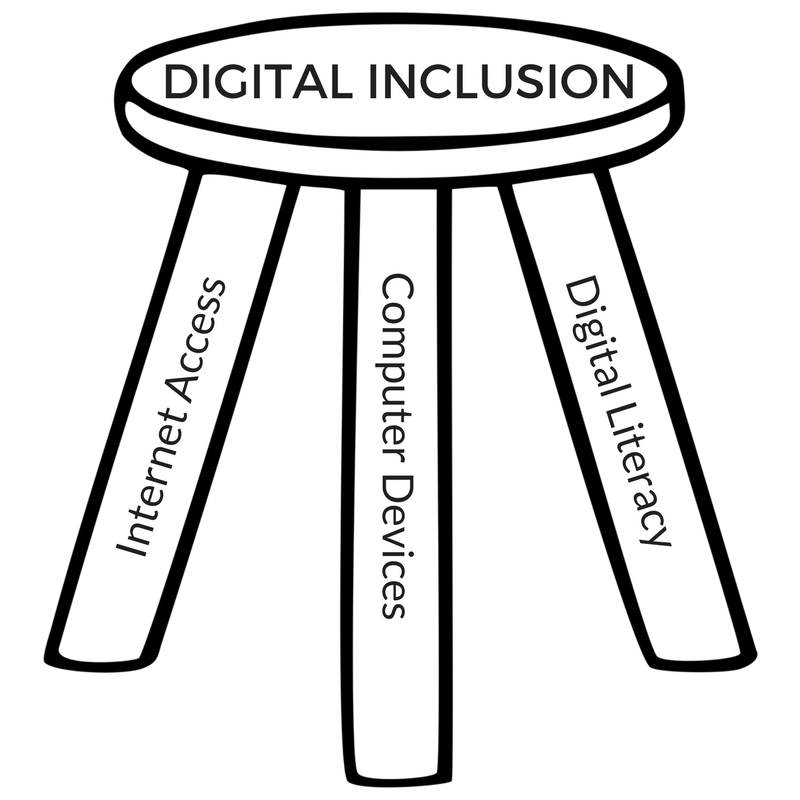Digital Divide
The term “digital divide” refers to the gap between individuals, households, businesses and geographic areas at different socio-economic levels with regard to both their opportunities to access information and communication technologies (ICTs) and to their use of the Internet for a wide variety of activities. (“Glossary of Statistical Terms: Digital Divide.” Organisation for Economic Co-operation and Development. Accessed July 2020. https://stats.oecd.org/glossary/detail.asp?ID=4719)

Digital Inclusion
Digital Inclusion refers to the activities necessary to ensure that all individuals and communities, including the most disadvantaged, have access to and use of Information and Communication Technologies (ICTs). This includes 5 elements:
- affordable, robust broadband internet service;
- internet-enabled devices that meet the needs of the user;
- access to digital literacy training;
- quality technical support; and
- applications and online content designed to enable and encourage self-sufficiency, participation and collaboration.
Digital Inclusion must evolve as technology advances. Digital Inclusion requires intentional strategies and investments to reduce and eliminate historical, institutional and structural barriers to access and use technology. (“Definitions.” National Digital Inclusion Alliance. Accessed July 2020. https://www.digitalinclusion.org/definitions/)
Digital Literacy
NDIA recommends the American Library Association’s definition of Digital Literacy via their Digital Literacy Taskforce: Digital Literacy is the ability to use information and communication technologies to find, evaluate, create, and communicate information, requiring both cognitive and technical skills.
A Digitally Literate Person:
- Possesses the variety of skills – technical and cognitive – required to find, understand, evaluate, create, and communicate digital information in a wide variety of formats;
- Is able to use diverse technologies appropriately and effectively to retrieve information, interpret results, and judge the quality of that information;
- Understands the relationship between technology, life-long learning, personal privacy, and stewardship of information;
- Uses these skills and the appropriate technology to communicate and collaborate with peers, colleagues, family, and on occasion, the general public; and
- Uses these skills to actively participate in civic society and contribute to a vibrant, informed, and engaged community.
(“Definitions.” National Digital Inclusion Alliance. Accessed July 2020. https://www.digitalinclusion.org/definitions/)
Media Literacy
Media literacy is the ability to ACCESS, ANALYZE, EVALUATE, CREATE, and ACT using all forms of communication. In its simplest terms, media literacy builds upon the foundation of traditional literacy and offers new forms of reading and writing. Media literacy empowers people to be critical thinkers and makers, effective communicators and active citizens. (“Media Literacy Defined” National Association for Media Literacy Education. Accessed July 2020. https://namle.net/publications/media-literacy-definitions/)
Digital Equity
Digital Equity is a condition in which all individuals and communities have the information technology capacity needed for full participation in our society, democracy, and economy. Digital Equity is necessary for civic and cultural participation, employment, lifelong learning, and access to essential services. (“Definitions.” National Digital Inclusion Alliance. Accessed July 2020. https://www.digitalinclusion.org/definitions/)
Information Literacy
Information literacy includes the ability to identify, find, evaluate, and use information effectively. From effective search strategies to evaluation techniques, students learn how to evaluate the quality, credibility, and validity of websites, and give proper credit. Information Literacy has also been referred to as digital literacy or media literacy. Regardless of the terminology, be it digital literacy or media literacy, having information literacy skills are the fundamentals to thrive in a digital space. (“Information Literacy” Common Sense Education. Accessed July 2020. https://www.commonsense.org/education/digital-citizenship/information-literacy)
Homework Gap
The homework gap occurs when students assigned homework requiring access to the internet don’t have home access. Nationally, 70% of teachers assign homework that requires broadband access, but only 33% of students have access at home. (“Homework Gap.” North Carolina Department of Information Technology Broadband Infrastructure Office. Accessed July 2020. https://www.ncbroadband.gov/broadband-north-carolina/state-broadband-plan/homework-gap)